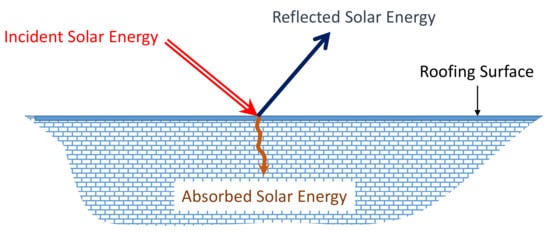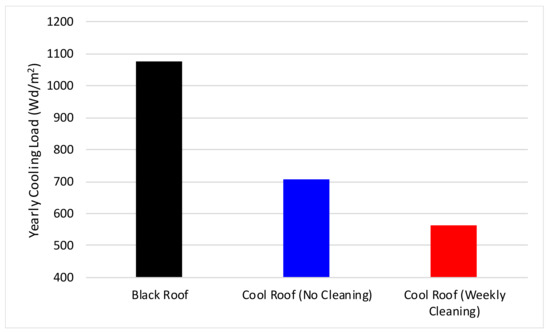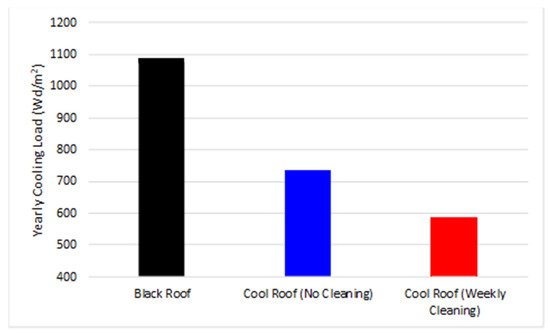The use of white roofing material is a suggestion because of its cooling, evaporative and efficiency characteristics compared to traditional black roofing materials. Many research studies have shown that the darker roofing surfaces that are prevalent in many urban areas actually can increase temperature by 1 to 3 degrees Celsius to the environment surrounding these urban areas. Additionally, improved temperature control and heat reflection also work to reduce the energy requirements for the interior spaces of the structures that have white roofing surfaces. The white or lighter colored roofs tend to reflect a part of the solar radiation that strikes the roof’s surface. Consequently, one might believe that white roofing material would be commonplace and especially so within emerging economies. Yet, this is hardly the case at all.
- cost-benefit
- energy savings
- urban heat island
1. Cool Roofs Pros and Cons and Its Relationship with the Weather
2. Application and Maintenance of Cool Roofs



This entry is adapted from the peer-reviewed paper 10.3390/su13179967
References
- Saber, H.H.; Maref, W.; Hajiah, A.E. Hygrothermal Performance of Cool Roofs Subjected to Saudi Climates. J. Front. Energy Res. 2019, 7, 39.
- Saber, H.H.; Maref, W. Energy Performance of Cool Roofs Followed by Development of Practical Design Tool. J. Front. Energy Res. 2019, 7, 122.
- Miller, W.; Crompton, G.; Bell, J. Analysis of Cool Roof Coatings for Residential Demand Side Management in Tropical Australia. Energies 2015, 8, 5303–5318.
- William, R.; Goodwell, A.; Richardson, M.; Le, P.V.; Kumar, P.; Stillwell, A.S. An environmental cost-benefit analysis of alternative green roofing strategies. Ecol. Eng. 2016, 95, 1–9.
- Saber, H.H.; Maref, W.; Abdulghani, K. Properties and Position of Materials in the Building Envelope for Housing and Small Buildings; National Research Council of Canada: Ottawa, ON, Canada, 2014.
- Saber, H.H.; Maref, W. Risk of condensation and mould growth in wood-frame wall systems with different exterior insulations. In Proceedings of the Building Enclosure Science & Technology Conference (BEST4 Conference), Kansas City, MO, USA, 16 April 2015.
- Lacasse, M.A.; Saber, H.H.; Maref, W.; Ganapathy, G.; Plescia, S.; Parekh, A. Field Evaluation of Thermal and Moisture Response of Highly Insulated Wood-Frame Walls. In Proceedings of the 13th International Conference on Thermal Performance of the Exterior Envelopes of Whole, Buildings XIII, Clearwater, FL, USA, 4–8 December 2016.
- Saber, H.H.; Lacasse, M.A.; Ganapathy, G.; Plescia, S.; Parekh, A. Risk of condensation and mould growth in highly insulated wood-frame walls. In Proceedings of the 13th International Conference on Thermal Performance of the Exterior Envelopes of Whole, Buildings XIII, Clearwater, FL, USA, 4–8 December 2016.
- Saber, H.H.; Lacasse, M.A.; Moore, T.V. Hygrothermal performance assessment of stucco-clad wood frame walls having vented and ventilated drainage cavities. In Advances in Hygrothermal Performance of Building Envelopes: Materials, Systems and Simulations, ASTM STP1599; ASTM International: West Conshohocken, PA, USA, 2017; pp. 198–231.
- Saber, H.H.; Hajiah, A.E.; Alshehri, S.; Hussain, H.J. Investigating the Effect of Dust Accumulation on Solar Reflectivity of Coating Materials for Cool Roof Applications. Energies 2021, 14, 445.
- Saber, H.H.; Swinton, M.C.; Kalinger, P.; Paroli, R.M. Long-term hygrothermal performance of white and black roofs in North American climates. Build. Environ. 2012, 50, 141–154.
- Saber, H.H.; Swinton, M.C.; Kalinger, P.; Paroli, R.M. Hygrothermal simulations of cool reflective and conventional roofs. In Proceedings of the 2011 NRCA International Roofing Symposium, Emerging Technologies and Roof System Performance, Washington, DC, USA, 7–9 September 2011.
- Brehob, E.; Desjarlais, A.; Atchley, J. Effectiveness of cool roof coatings with ceramic particles. In Proceedings of the 2011 International Roofing Symposium, Washington, DC, USA, 7–9 September 2011.
- Urban, B.; Roth., K. Guidelines for Selecting Cool Roofs. Building Technologies Program; 2010. Available online: https://www.energy.gov/sites/prod/files/2013/10/f3/coolroofguide.pdf (accessed on 1 June 2021).
- Ennis, M.; Kehrer, M. The effects of roof membrane color on moisture accumulation in low-slope commercial roof systems. In Proceedings of the 2011 international roofing symposium, Oak Ridge, TN, USA, 1 January 2011.
- Bludau, C.; Zirkelbach, D.; Kuenzel, H.M. Condensation problems in cool roofs. Interface J. RCI 2009, XXVII, 11–16.
- Bludau, C.; Künzel, H.M.; Zirkelbach, D. Hygrothermal performance of flat roofs with construction moisture. In Proceedings of the Eleventh International Conference on Thermal Performance of the Exterior Envelopes of Whole Buildings, Clearwater, FL, USA, 4–8 December 2016.
- Saber, H.H. Hygrothermal Performance of Cool Roofs with Reflective Coating Material Subjected to Hot, Humid and Dusty Climate. J. Build. Phys. 2021.
- Saber, H.H.; Hajiah, A.E. 3D Numerical Modeling for Assessing the Energy Performance of Single- and Two-Zone Buildings with and without Phase Change Materials. In Proceedings of the Gulf Conference on Sustainable Built Environment, Kuwait City, Kuwait, 10–13 March 2019; pp. 10–13.
- Hajiah, A.E.; Saber, H.H. Long-Term Energy and Moisture Performance of Reflective and Non-Reflective Roofing Systems with and without Phase Change Materials under Kuwaiti Climates. In Proceedings of the Gulf Conference on Sustainable Built Environment, Kuwait City, Kuwait, 10–13 March 2019; pp. 10–13.
- Green Technologies and Energy Efficiency (GTEE 2017) workshop at the King Faisal University in Saudi Arabia, 26 April 2017. Available online: https://img0cf.b8cdn.com/images/course/35/68573835_1594764313.pdf (accessed on 1 June 2021).
- Pisello, A.L.; Castaldo, V.L.; Pignatta, G.; Cotana, F.; Santamouris, M. Experimental in-lab and in-field analysis of waterproof membranes for cool roof application and urban heat island mitigation. Energy Build. 2016, 114, 180–190.
- Saber, H.H.; Alshehri, S.A.; Alnofaie, M.; Alghamdi, A.; Alraghi, S.; Hajiah, A.E. Energy Savings Due to Using Reflective Roofing Materials in Buildings of Kuwait and Saudi Arabia; Internal and Client Report (Confidenti—Part I); Kuwait Institute for Scientific Research (KISR): Kuwait City, Kuwait, 2019; Volume 67.
- Li, H. Evaluation of Cool Pavement Strategies for Heat Island Mitigation ; Final Research Report ; Institute of transportation studies, Department of Civil Environmental Engineeing, Unversity of California: Davis, CA, USA, 2012; Available online: https://escholarship.org/content/qt6mr4k9t1/qt6mr4k9t1_noSplash_9ab61b14762e84b7d61994b7aa5e0d1b.pdf?t=pyhuvm (accessed on 1 June 2021).
- Green Roofs. Reducing Urban Heat Islands: Compendium of Strategies: Heat IslandReduction Activities. 2018. Available online: https://healthyplacesindex.org/wp-content/uploads/2018/01/epa_heat_island_reduction_activities.pdf. (accessed on 1 June 2021).
- Berdahl, P.; Akbari, H.; Levinson, R.; Miller, W.A. Weathering of roofing materials—An overview. Constr. Build. Mater. 2008, 22, 423–433.
- Suehrcke, H.; Peterson, E.L.; Selby, N. Effect of roof solar reflectance on the building heat gain in a hot climate. Energy Build. 2008, 40, 2224–2235.
- Algarni, S.; Nutter, D. Influence of dust accumulation on building roof thermal performance and radiant heat gain in hot-dry climates. Energy Build. 2015, 104, 181–190.
- Levinson, R.; Berdahl, P.; Asefawberhe, A.; Akbari, H. Effects of soiling and cleaning on the reflectance and solar heat gain of a light-colored roofing membrane. Atmos. Environ. 2005, 39, 7807–7824.
- Akbari, H.; Berhe, A.; Levinson, R.; Graveline, S.; Foley, K.; Delgado, A.H.; Paroli, R.M. Aging and Weathering of Cool Roofing Membranes. In Proceedings of the First International Conference on Passive and Low Energy Cooling for the Built Environment, Athens, Greece, 17 May 2005.
- Saber, H.H.; Alshehri, S.A.; Alnofaie, M.; Alghamdi, A.; Alraghi, S.; Hajiah, A.E. Energy Savings Due to Using Reflective Roofing Materials in Buildings of Kuwait and Saudi Arabia. Client Report—Part II. Unpublished work. 2020.
